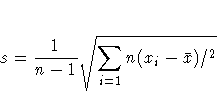Chapter Contents
Previous
Next
|
Chapter Contents |
Previous |
Next |
| PROC CAPABILITY and General Statements |
In many industries,
statistical control
is routinely checked
with a Shewhart chart
(such as an ![]() and R chart)
before capability indices such as
and R chart)
before capability indices such as



Some industry manuals distinguish
these two approaches.
For instance,
the ASQC/AIAG manual
Fundamental Process Control
uses the
notation Cpk for
the estimate based on sR,
and it uses
the notation Ppk
for the estimate based on s.
However, assuming that the process is in control
and only common cause variation is present,
both sR and s are estimates of the
same parameter ![]() ,and so there is fundamentally
no difference in the two approaches*.
,and so there is fundamentally
no difference in the two approaches*.
Once control has been established, attention shuld focus on the distribution of the process measurements, and at this point there is no practical or statistical advantage to working with subgrouped measurements. In fact, the use of s is closely associated with a wide variety of methods that are highly useful for process capability analysis, including tests for normality, graphical displays such as histograms and probability plots, and confidence intervals for parameters and capability indices.
|
Chapter Contents |
Previous |
Next |
Top |
Copyright © 1999 by SAS Institute Inc., Cary, NC, USA. All rights reserved.